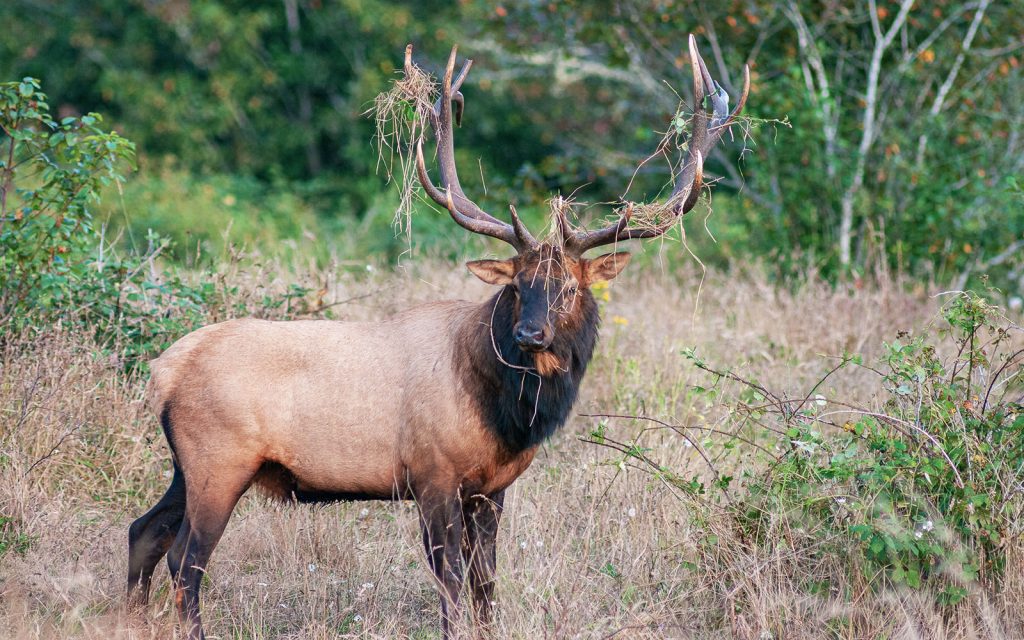
MODULE 16 - HUNTING ROOSEVELT ELK
CHAPTER 1: OVERVIEW OF ROOSEVELT ELK HUNTING

WHAT IS A ROOSEVELT ELK?
The Roosevelt (Olympic) Elk occupy a large range along the coast of the western US from northern California up into British Columbia. A herd of Roosevelt elk was also transplanted in Alaska on Afognak and Raspberry Islands. Roosevelt Elk are the largest bodied of the elk subspecies.
From a record-book standpoint, Pope and Young and Boone and Crockett recognize Roosevelt elk as elk that live geographically west of I-5.
In the early 1900’s, their population had plummeted to just a handful. Theodore Roosevelt created Mount Olympus National Monument in Washington State for the purpose of preserving Roosevelt Elk for future generations to enjoy. Today, their total populations are around 80,000, with the majority of those being in the coastal range of Oregon.
WHERE CAN YOU HUNT ROOSEVELT ELK?
All of the states/provinces that have Roosevelt Elk populations allow hunting for Roosevelt Elk, at least to some degree.
CALIFORNIA
In California, there is a very limited number of Roosevelt Elk tags, and those tags are further limited to “no more than 1” elk tag being available for non-residents. California does have the option of buying a Landowner Tag for Roosevelt Elk, but they are VERY expensive ($20,000+ for a mature bull elk hunt).
ALASKA
Alaska also has a draw for Roosevelt Elk tags, and issues 500-600 total tags (residents and non-residents) for both bulls and cows. Draw odds are not great, especially for the bull tags during the better seasons. The terrain is difficult to hunt, and the antlers the elk in Alaska grow are not known for being big.
BRITISH COLUMBIA
Vancouver Island in British Columbia is home to some of the largest-antlered Roosevelt Elk in the world. Non-residents in BC are required to hunt with an outfitter, and a Roosevelt Elk hunt in BC will cost you dearly. Most outfitters don’t even list the cost of their Roosevelt Elk hunts on their websites, but you can expect to pay $20,000+ to hunt them as a non-resident.

WASHINGTON
Washington State has some good draw areas for Roosevelt Elk Hunting, but in order to apply for a controlled Roosevelt Elk hunt, a non-resident must first purchase a non-refundable elk license. Fortunately, Washington also offers some great opportunities for OTC Roosevelt Elk hunting for both residents and non-residents.
OREGON
Oregon is home to more Roosevelt Elk than all the other areas/states combined. Most of the coastal range of Oregon is also open to OTC hunting for Roosevelt Elk. While there is a considerable amount of private timber company land (most of which can be accessible by paying a nominal “trespass” fee), there is also ample amounts of National Forest and other accessible land for hunting.
ROOSEVELT ELK VS. ROCKY MOUNTAIN ELK…
Much of the content discussed throughout the University of Elk Hunting Online Course is applicable to hunting any species of Elk, and throughout any season. However, there are some differences between Roosevelts and “Rockys” that are worth noting.
First, Roosevelt Elk are bigger bodied than their Rocky Mountain counterparts. A mature Roosevelt Elk will weight 150-200 pounds more than a Rocky Mountain Elk. A Roosevelt bull in Alaska is even bigger bodied! Antler-wise, Roosevelt Elk have smaller antlers generally speaking, but their antlers are often massive and can become crowned at the top. These differences, however, really have no effect on how you will hunt them. But there is something magical about those orange-tinted, black antlers emerging from the suffocating foliage where these beasts live!
THE TERRAIN
When it comes to hunting Roosevelt Elk, the biggest difference you will experience will be the terrain, along with a handful of effects that are created by the geography where Roosevelt Elk live. The coastal region of the western U.S. and Canada is thick. Words won’t adequately describe what I’m trying to say, but just understand that you will probably be incredibly surprised by how thick the vegetation really is – even if you already imagine it to be the worst. Just finding a place to step off the road and dive into the brush can be difficult. This thick, suffocating vegetation definitely creates some challenges that you will need to be prepared for if you intend to hunt Roosevelt Elk.
And Speaking of Challenges, Click ‘Next Chapter’ Below to Continue to Chapter 2: A Slap in the Face





